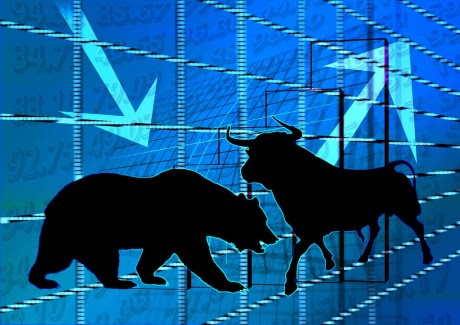It’s official – global stocks have entered a bear market. On Wednesday, we learned that the MSCI All-Country World Index has fallen a total of more than 20 percent from the peak of the market. So that means that roughly one-fifth of all the stock market wealth in the entire world has already been wiped out.
How much more is it going to take before everyone will finally admit that we have a major financial crisis on our hands? 30 percent? 40 percent? This new round of chaos began last night in Asia. Japanese stocks were down more than 600 points and Hong Kong was down more than 700 points. The nightmare continued to roll on when Europe opened, and European stocks ended up down about 3.2 percent when the markets over there finally closed. In the U.S., it looked like it was going to be a truly historic day for a while there. At one point the Dow had fallen 566 points, but a curious rebound resulted in a loss of only 249 points for the day.
As bad as things are in the U.S. right now, the truth is that we still have a long way to go to catch up with the rest of the planet. Around the world, many major stock indexes are already down more than 30 or 40 percent. Overall, the MSCI All-Country World Index is now down 20 percent, which officially puts us in bear market territory…
The MSCI All-Country World Index, which measures major developed and emerging markets, fell into a bear market Wednesday, with its decline from early last year now totaling more than 20 percent.
A plunge in U.S. stocks, which caused the Dow Jones industrial average to decline by more than 400 points at one point, pushed the global index into bear territory at midmorning during New York trading.
Japan fell into a bear market as well as the Nikkei 225 index dropped 3.7 percent Wednesday, bringing its total pullback to 22 percent from its high in June.
Much of this chaos is being driven by the price of oil. On Wednesday the price of U.S. oil dropped below 28 dollars a barrel for a while, and as I write this article Brent crude is still below 28 dollars a barrel.
As energy prices continue to plummet, this is putting a tremendous amount of pressure on junk bonds. On Wednesday JNK actually dipped beneath 32.00 for a time before rebounding at the end of the day. I expect to see junk bonds continue to crash during the days ahead as investors feverishly race for the exits.
And of course global economic fundamentals continue to deteriorate as well. Global trade is absolutely imploding and shipping rates have fallen to unprecedented levels. If you can believe it, Bloomberg is reporting that it is now actually cheaper to rent a 1,100 foot merchant vessel than it is to rent a Ferrari…
Rates for Capesize-class ships plummeted 92 percent since August to $1,563 a day amid slowing growth in China. That’s less than a third of the daily rate of 3,950 pounds ($5,597) to rent a Ferrari F40, the price of which has also fallen slightly in the past few years, according to Nick Hardwick, founder of supercarexperiences.com. The Baltic Exchange’s rates reflect the cost of hiring the vessel but not fuel costs. Ships burn about 35 metric tons a day, implying a cost of about $4,000 at present prices, data compiled by Bloomberg show.
I could hardly believe that when I first read it.
But this is the kind of thing that we would expect to see happen when the greatest financial bubble in world history bursts.
The 200 trillion dollar global debt pyramid is now collapsing all around us, and the former chief economist of the Bank for International Settlements is warning that we could soon be facing “an avalanche of bankruptcies”…
The global financial system has become dangerously unstable and faces an avalanche of bankruptcies that will test social and political stability, a leading monetary theorist has warned.
“The situation is worse than it was in 2007. Our macroeconomic ammunition to fight downturns is essentially all used up,” said William White, the Swiss-based chairman of the OECD’s review committee and former chief economist of the Bank for International Settlements (BIS).
Of course it is a little late in the game to be warning us about this now.
At this point there is very little that can be done to stop the collapse that is already happening.
White went on to tell the Telegraph that things are going to become “uncomfortable for a lot of people who think they own assets that are worth something”…
“It will become obvious in the next recession that many of these debts will never be serviced or repaid, and this will be uncomfortable for a lot of people who think they own assets that are worth something,” he told The Telegraph on the eve of the World Economic Forum in Davos.
For years, I have been warning that the global financial system is an incredibly shaky house of cards, and now we have finally reached the endgame.
But the mainstream media in the United States is telling everyone not to panic. Instead of a time to sell, the mainstream media is urging people to jump in and take advantage of all of the “great deals” in the stock market right now. I really like what Mike Adams of Natural News had to say about what we are seeing…
The pathetically stupid and dishonest financial media is desperately running stories right now to maintain false faith in the markets, even while their own people are behind the scenes selling like mad. As long as they can keep the public believing in the “faith” of never-ending cheap money, they can bail out their own positions to suckers and fools who think a tiny dip in a massively overvalued, fraudulent market is a “buying opportunity.”
Watch for desperate headlines from propaganda financial outlets (such as MarketWatch.com) like, “10 reasons you shouldn’t sell” or “The upside potential of the market is HUGE!” These are psychological operations to try to persuade people that the collapse they’re seeing in global markets isn’t actually happening.
The financial chaos that has erupted in recent weeks has really caught a lot of people by surprise, but my readers knew that it was coming well in advance.
For months, I have been warning about this exact kind of scenario.
The deflationary financial meltdown that started during the last six months of 2015 is now making headlines all over the planet, and what we have experienced so far is just the tip of the iceberg.
The bears have gotten out of their cages, and global investors are running for cover. Nobody is exactly sure what is going to happen tomorrow, but without a doubt the entire world will be watching.










